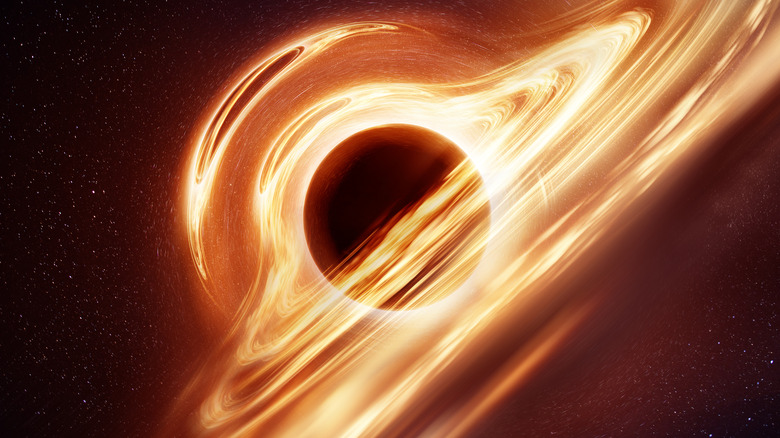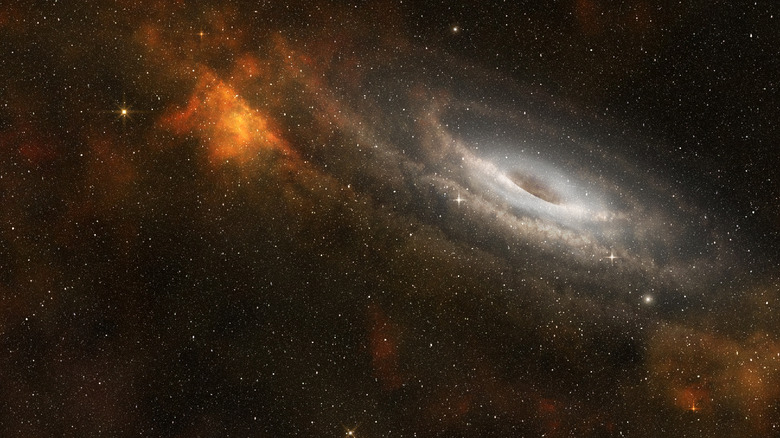Why The Term Black Hole Is A Mind-Boggling Misnomer
So a black hole is a hole, right? Why else would we call it a "hole"? It's this big space mouth thing that eats up matter and is so massive that not even light can escape its gravity. Ok, that's partially true. But thanks to the limits of language, astronomer John Wheeler might have thrown us off the trail when he coined the term "black hole" back in 1967, per Space.com. Granted, maybe "infinitely dense spacetime singularity" wouldn't make sense to the general public. Now, we've got to backtrack and clear up our definitions a bit, especially since black holes have been the subject of a whole lot more research since Albert Einstein first predicted their existence back in 1916.
Let's do a quick recap, starting with the different kinds of black holes: primordial, stellar, supermassive, ultramassive, SLAB (stupendously large black hole), and maybe even black hole suns (quasi-stars with black holes for cores), per NASA, Space.com, and New Scientist. Each of these is bigger than the one before it, and the bigger it is the less we understand. There are also white holes, per Science Alert, which are like inverse black holes that spew out all matter rather than draw it all in. So for the sake of this article, let's stick with typical stellar black holes. Per NASA, these black holes form when a star gets old, goes boom — supernova — and the remnants collapse into an infinitely dense point. That's the key word: point, not hole.
A spot of infinitely sinking ink
Einstein's 1915 Theory of General Relativity describes spacetime as a "fabric," per Space.com. Gravity is like a dent in that fabric. Imagine you and three other people are pulling tightly at the corners of a bedsheet. Someone else drops a marble on the bedsheet and the bedsheet sinks a tad. Boom: small gravity like the moon. The Earth? Maybe that's a baseball — it sinks more than the marble and distorts the fabric around it like a drain. The sun? Maybe that's a bowling ball that sinks even further. And a black hole? It's a spot of ink that sinks like Thor's hammer straight to the floor.
You'll notice that the deeper something sinks, the bigger the radius of fabric around it that gets distorted. For a black hole this edge of no return is called the event horizon, beyond which things roll down to the center. Wondrium Daily says that the radius of the event horizon — the Schwarzschild Radius – increases in proportion to the mass of the black hole. Then there's the black hole's accretion disc, a spinning, super fast band — as large as an entire galactic center for larger black holes, per Sky at Night Magazine — around which objects orbit like planets around the sun. And the black hole itself? It has no surface and no interior, and nothing goes inside it. Everything that gets too close accelerates towards light-speed and gets "spaghettified" into atoms, per Royal Museums Greenwich.
A spaghettifying fuzzball
But, you've heard, nothing can escape a black hole. It's gravity is so strong that not even light can escape. If the singularity is a point at the center of a black hole — an entire phenomenon that includes its event horizon and accretion disc — that has no dimensionality (i.e., length, width, height), what happens to stuff that it traps? Well, this is the fun part: because the singularity is infinitely dense, it can draw in all it wants to the same, single point. As Wondrium Daily explains, the Schwarzschild Radius — the event horizon radius — will grow, but not the point in the middle.
We can think of the Big Bang to help explain. Researchers used to conceive of the Big Bang as a singularity, per Big Think. All the matter in the universe was already present in an infinitely dense point that expanded along with the expansion of space. A black hole is the same kind of thing: a dent, crimp, warp — take your pick — in the fabric of spacetime. It's not an object with an inside and outside like a box or hole.
Some researchers postulate that black holes are actually clumps of garbled, one-dimensional strings like balls of cosmic yarn, as Live Science explains. This isn't proven yet — it's just a way to explain how something like an "infinitely dense spacetime singularity" could physically exist. But either way, "ball of yarn" is probably as inaccurate as "hole."


